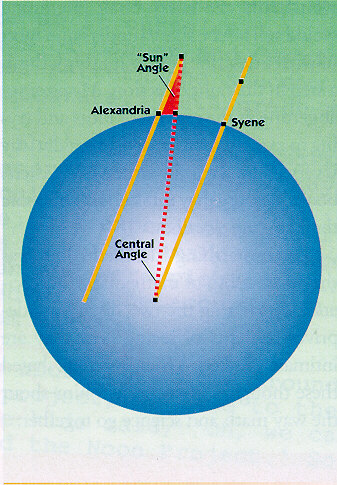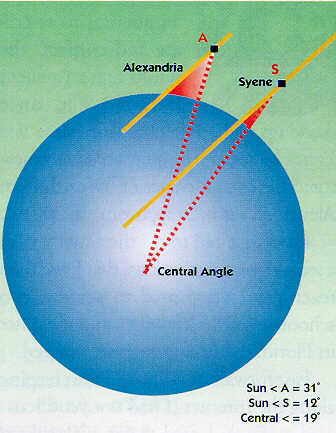- Home
- Collaborate Now
- Collaboration Center
- Resources for Collaboration
- Classic GSN Articles
- Eratoshthenes in Schools

Eratosthenes in Schools
by Al Rogers 1998 (updated June 2006)

While reading the February, 1998 issue of National Geographic Magazine, I was interested to see a picture of Eratosthenes' ancient well near Aswan, Egypt... taken at the summer solstice when the sun reflects directly off the water at the bottom of the deep hole.
Over 2100 years ago, Eratosthenes observed this same phenomenon and used it to calculate the circumference of the earth. (This is the same Eratosthenes who developed the sieve to discover prime numbers).
A week or so later, in the March 1998 issue of Learning and Leading with Technology Magazine I read "In the Spirit of Eratosthenes: Measuring the Circumference of the Earth" by Ihor Charischak. This is an interesting write-up of today's Internet version of Eratosthenes ancient feat.
Since the very first Eratosthenes project was conducted on GSN's old FrEdMail Network in 1987, I thought it would be fun to trace its history and find out who's carrying on the venerable tradition of keeping Erathosthenes spirit alive.
 I created and published the very first Eratosthenes Project appeared in March, 1987 on GSN's old FrEdMail network. Kathleen Smith, a high school math teacher in Champaign, Illinois, signed onto the project that first year. This project was included in an article in the Computer Teacher Magazine in 1989. Kathleen continues to conduct this project each year with her high school math students. Tom O'Briain, our FrEdMail Sysop in Dublin, Ireland, wrote about their participation in the 1992 project.
I created and published the very first Eratosthenes Project appeared in March, 1987 on GSN's old FrEdMail network. Kathleen Smith, a high school math teacher in Champaign, Illinois, signed onto the project that first year. This project was included in an article in the Computer Teacher Magazine in 1989. Kathleen continues to conduct this project each year with her high school math students. Tom O'Briain, our FrEdMail Sysop in Dublin, Ireland, wrote about their participation in the 1992 project.
The Maryland Virtual High School has some useful and interesting materials related to this project in their Shadow Tracks, and have broadened their project collection to also include collaborative projects to measure the velocity of Earth's rotation, Determine North and Magnetic North, and Measure the Distance to the Moon.
James D. Meinke conducts an annual project at Youth Net.
Ken Cole conducts an annual project at McKinney High School.
Ihor Charischak, the author of the informative article in the March 1998 issue of Learning and Leading with Technology, (and the source of the illustrations on this page) has also developed an informative Eratosthenes project page and conducts the excellent Stevens Institute for Technology Noon Day Project.
A Google search using the terms "calculate circumference earth" will find many additional opportunities to participate in this great project.
All of this illustrates that a good, simple, well-designed project can have high value regardless of the technology, and demonstrates again that content (i.e., what you do) is more important than the technology itself.
Al Rogers
March, 1998
